| Columns Retired Columns & Blogs |
Classé CDP-10 CD player Measurements
Sidebar 3: Measurements
At 1.98V, the Classé CDP-10's maximum output level at 1kHz from the unbalanced outputs basically conformed to the 2V CD standard, this exactly doubling from the balanced jacks, as expected. Neither output inverted signal polarity, the XLRs being wired with pin 2 hot, and the output impedance was respectably low, at 47.8 ohms (unbalanced) and 95.1 ohms (balanced). (Both figures include the series resistance of 6' of interconnect cable.) Error correction was superb, the player coping with gaps in the data spiral of up to 1.5mm in length without audible dropouts. Only on track 34 of the Pierre Verany Test CD, which has 2mm gaps, were there audible glitches.
The CDP-10's frequency response was identical from both balanced and unbalanced outputs, and drooped slightly in the top octave, reaching -1.3dB at 20kHz (fig.1, top pair of traces). With pre-emphasized data, however, the treble response shelved down by an audible 1.8dB. Fortunately, CDs requiring de-emphasis are rare, but I was surprised to see an implementation error of this magnitude. (As the PCM1738 DAC chip used in the CDP-10 can apply de-emphasis in the digital domain, this error appears to show that Classé implements de-emphasis in the analog domain, which is the theoretically better way of doing it.)
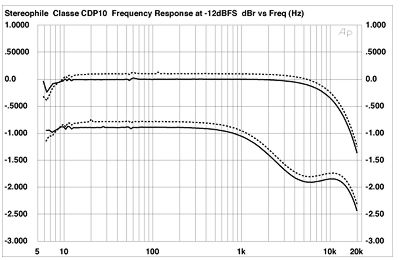
Fig.1 Classé CDP-10, unbalanced outputs, frequency response at -12dBFS into 100k ohms, with de-emphasis (bottom) and without (top). (Right channel dashed, 0.5dB/vertical div.)
Channel separation (not shown) was superb, any crosstalk lying below -120dB below 10kHz. That I could even measure this is a tribute to the CDP-10's very low level of noise. The noise floor you can see in fig.2, therefore, is entirely due to the dither contained in the test signal. But note the complete absence of distortion or power-supply-related spuriae. Extending the measurement bandwidth to 200kHz and repeating the spectral analysis of the Classé's analog output while it decoded "digital black" gave the traces shown in fig.3. Other than some low-frequency noise that is mainly in the left channel, the audioband noise floor is very low in level. The rise in the floor above 25kHz is due to the noise-shaping used by the DAC chips and is subjectively benign.
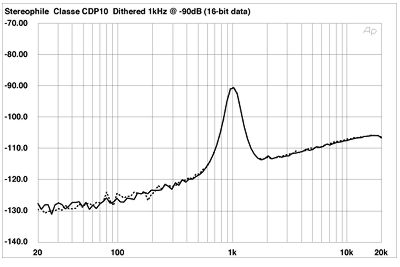
Fig.2 Classé CDP-10, balanced, 1/3-octave spectrum of dithered 1kHz tone at -90dBFS, with noise and spuriae (16-bit data, right channel dashed).
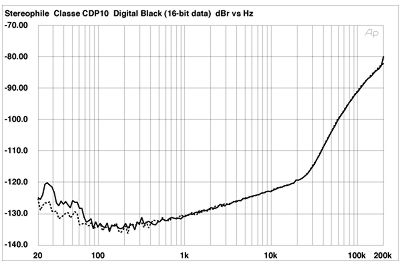
Fig.3 Classé CDP-10, balanced, 1/3-octave spectrum of digital black, with noise and spuriae (16-bit data, right channel dashed).
Again as a result of the player's low analog noise, the noise apparent in fig.4, a graph of the right channel's linearity error, is predominantly due to the signal dither. This graph does reveal that if there is any error in the CDP-10's DACs, it lies beneath the noise floor to below -110dBFS, which is superb. With low noise and low linearity error, the Classé's reproduction of an undithered 16-bit, 1kHz waveform at -90.31dBFS is essentially perfect (fig.5). The three voltage levels and the transitions between them that comprise this signal are clearly defined.
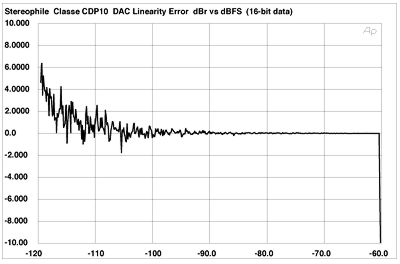
Fig.4 Classé CDP-10, balanced, right-channel departure from linearity, 16-bit data (2dB/vertical div.).
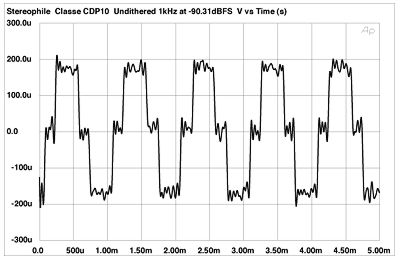
Fig.5 Classé CDP-10, balanced, waveform of undithered 1kHz sinewave at -90.31dBFS, 16-bit data.
The Classé CDP-10 also featured very low levels of harmonic and intermodulation distortion. Fig.6 shows the spectrum of the player's left output while it drove 50Hz at full level into 100k ohms. The highest harmonic is the second, but at -97dB (0.0014%), this won't bother anyone. The right channel was even better than the left, with the second harmonic lying at just -106dB (0.0005%)! This was from the balanced outputs, but the unbalanced were just as good. And if there were any intermodulation products resulting from the Classé driving an equal mix of 19kHz and 20kHz tones, they were below the resolving power of my Audio Precision System One, even into the punishing 600 ohm load (fig.7).
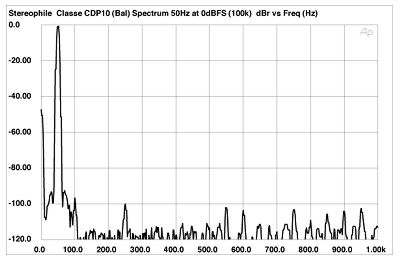
Fig.6 Classé CDP-10, balanced, spectrum of 50Hz sinewave, DC-1kHz, at 0dBFS into 100k ohms (linear frequency scale).
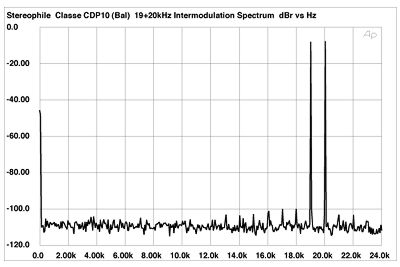
Fig.7 Classé CDP-10, balanced, HF intermodulation spectrum, DC-24kHz, 19+20kHz at 0dBFS into 600 ohms (linear frequency scale).
Finally, fig.8 shows a narrowband spectrum of the CDP-10's output while it decoded undithered data representing a high-level tone at exactly one quarter the sample rate, over which has been overlaid a low-frequency squarewave at the LSB level. The latter maximally exercises bit transitions, the former provides a diagnostic signal; as both signals are precise submultiples of the sampling frequency, any spuriae that appear in the player's or processor's analog output are not due to the quantization of the digital signal but to the product being tested.
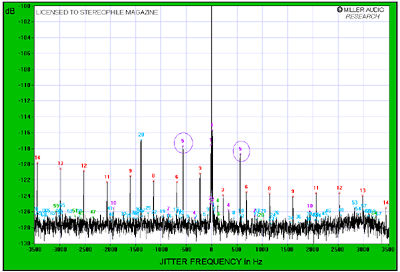
Fig.8 Classé CDP-10, unbalanced, high-resolution jitter spectrum of analog output signal (11.025kHz at -6dBFS sampled at 44.1kHz with LSB toggled at 229Hz). Center frequency of trace, 11.025kHz; frequency range, ±3.5kHz.
The very narrow vertical peak in fig.8 is the 11.025kHz tone. The sideband pairs around that peak are due to word-clock jitter or to other such sources of error. The overall sum of the jitter components in this graph is a superbly low 177 picoseconds. The sidebands indicated with red numeric markers lie at harmonics of the low-frequency squarewave; they are all very low in level. While two higher-level pairs can be seen, at ±15.6Hz (purple "1") and ±564Hz (purple "5"), these are both still low in level.
It is hard to see how 16-bit digital audio reproduction can get much better than this.—John Atkinson
- Log in or register to post comments



































